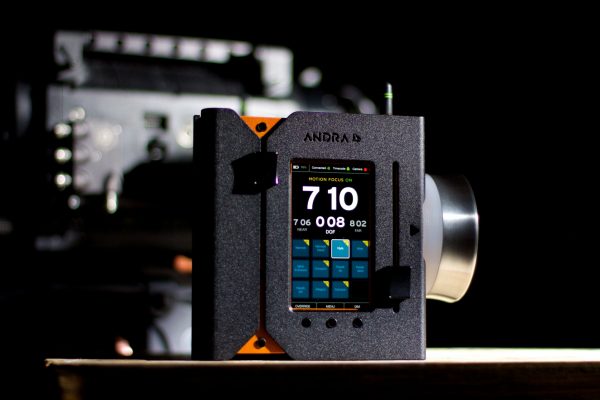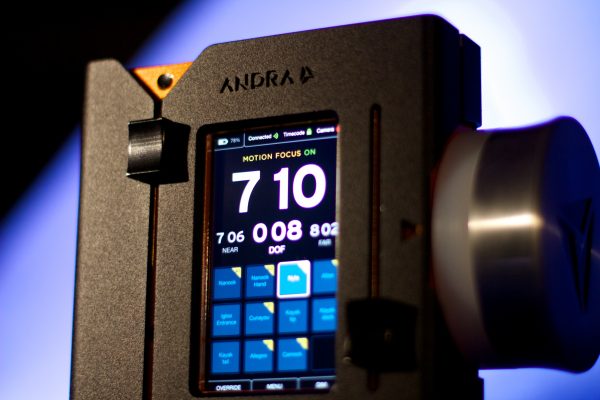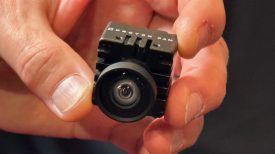By technical editor Matt Allard:
It is not often that we see truly revolutionary products on Newsshooter. I don’t like the term “game changer” but it is the phrase that sprung to mind when I first saw the details of Andra. I think the system is destined to be an instant hit.
The Andra Motion Focus system from Cinema Control Laboratories is as brilliant as it is unique. We have seen lots of follow focus and motion control systems but none have the capabilities of Andra.
When I first saw the video footage showcasing Andra my first thought was how are they doing this? So to explain the Andra system in a lot more detail I talked to Sam Fisher, CIO of Cinema Control Laboratories.
Q. How does the Andra system work?
A: The system is essentially a hybridization of a motion capture system and a remote focus pulling system. Using a portable and easy to set up magnetic mo-cap system we’re able to very accurately track subjects and cameras in real time and use that data to drive a lens control motor. The mo-cap side of the system uses very small sensors which can be mounted to the performer beneath clothing, just like a lavalier microphone. The user can then decide where they want the focal point, relative to that sensor, and the system does the rest. We are able to get very impressive accuracy which, most importantly allows you to get really crisp eye focus. We don’t just target the general area of a person, we get the focus right where you want it.
There are two ways to interface with the system. The basic approach to use an iPad, which opens up a whole new world of creative options. Another option is to use the hand unit (The Arc) which is similar to hand units currently on the market except that it has a touch screen interface and offers an incredible range of new features, like the ability to simply sequence between desired focal points by simply hitting a button or turning the dial back and forth.

The system can also be used to “save” positions of non moving objects in any given area, and, for dyed in the wool focus pullers who want to do it all manually, the hand unit streams live distance data of any chosen subject or object whether it’s moving or stationary. Basically it’s like having a Cinetape on several objects at once. You can choose to let the system pull focus for you, allowing you to simply decide when and how fast to move between subjects, or you can just use the data to pull manually.
Q. What was the inspiration for developing the system?
A: Among other things I have been teaching film at NSCAD University in Canada for ten years now. After watching my students struggle with focus for many years I decided there had to be a better way to deal with this technical challenge. I spent about a year in working in the lab on a proof of concept, and began working very closely with a one time NASA programmer, Mike MacDonald. We were able to really prove that the technology was finally here to allow a system like this to work, but there’s a long road between proof of concept and final product. That’s when we got together with technology research and development company, Sunsel Systems, which is helmed by Julian Taylor and Jeff Levy, and after climbing a veritable mountain of technology, we’re finally ready to show the world what we’ve been working on.
Q: How long has the system been in development and what problems and obstacles have you had to overcome?
A: It’s been in development for about 4 years. Obstacles, Yeah, there’s been lots of those. It wasn’t nearly as easy as I thought it would be. Firstly, I don’t think I ever clued in to just how precise focus has to be. We made a decision really early on to do all our testing on wide open lenses, which was the right choice, but it didn’t make our lives easy. With wide open lenses you’re often in the 5mm range for tolerance. Getting clean data down to that level of accuracy is only half the battle, because right away you’re into problems of data lag. A human can anticipate, usually because they’ve had a rehearsal, but a machine can’t, so that means it has to be really fast. Our initial design simply had too much lag, which meant that even a person walking at a moderate speed was always slightly behind, and therefore slightly soft. This is where Jeff Levy and Julian Taylor, owners of Sunsel Systems, were able to make the difference. We went right back to the drawing board and built a whole new system. When tracking a moving object Lag is now nominally at 75 milliseconds – which is basically imperceptible- and we’re pretty sure we can get it lower still. If you consider that even high end focus systems on the market currently have a lag in the same range, and all they’re doing is turning the dial with no data processing at all, then you get a sense of how optimized the system is.
Q: What lenses will it work on? Can it work on stills and cinema lenses?
A: The system will work with any cine lens: that is to say, any lens that has focus gears. Each lens needs to be calibrated once and then it can be stored in the app. There is no limit to how many lenses you can store. So far we’ve tested the system on Cooke Zeiss, Canon and Rockinon lenses, but we see no reason why it won’t work on any cine type lens. We’re also hoping to begin working with lens manufacturers to start building a database of lenses and make sure we can find ways to continue to optimize system performance.
Q: Is it going to be an expensive high end system targeting cinema or will it be affordable to a wider audience?
A: Obviously we want to get the price down as low as we can to make it accessible to wider audiences, which is difficult since we’re offering a full FIZ system. We’re offering early adopter pricing at NAB. We expect the hand unit and control box starter pack, which gives you a mo-cap ready FIZ system to be in the $7900 range.
A starter system ideal for low end users with full mo-cap features should be about $12,000. The system is scalable, so the bigger your system, the larger the motion capture range can be, but you can start small, get used to the system and let it grow with you over time. Like I said, these are early adopter prices and like all new technology prices, are subject to change.
Q: Why is it unique?
A: Well, I think it’s fairly obvious, but a few things it can do that you can’t do otherwise right now.
Imagine you’re shooting an interview with a handheld DSLR and you’re a one man crew. This system can pull focus for you.
Imagine you have a really complex shot with 16 focus pulls in it. That’s a lot of marks on your focus dial and a lot of confusion. This system has a sequencer built in. You can do that by tapping your finger on a single button.
Imagine being an actor and not having to hit your marks.
Ever tried to shoot on a Movi? Ever tried to pull focus on an improvised performance? Ever filmed a dog running around? These are all really difficult things to achieve, but with the help of the Andra Motion Focus system it gets a lot easier.
I am very curious to see just how well the Andra system works in real world shooting conditions.

Cinema Control Laboratories and the Andra Motion Focus System will be at the 2014 NAB Show in Vegas at booth C9548. The Newsshooter team will be there to check it out.







